hacking-gpt
using mechinterp to hack a PPO-ed GPT-2
Are PPO-ed Language Models Hackable?
Exploring how reinforcement learning “aligns” language models and whether this alignment can be circumvented through mechanistic understanding. This research was written in spring of 2024 (back when RLHF was still somewhat popular).
The Alignment Challenge
Large language models come with a fundamental problem: they often exhibit undesirable behaviors like toxicity, bias, and negative sentiment. This has led to the widespread adoption of Reinforcement Learning from Human Feedback (RLHF) and specifically Proximal Policy Optimization (PPO) to “align” these models with human preferences.
The critical question we are interested in: Are these alignment techniques actually removing harmful capabilities, or are they simply learning to hide them?
Our research tackles this question head-on by examining GPT-2 through the lens of mechanistic interpretability before and after PPO training. What we discovered has important implications for AI safety and the robustness of current alignment methods. Recent research by Lee et al. (2024) discovered that models aligned with Direct Preference Optimization (DPO) to avoid toxicity don’t actually remove toxic knowledge—they just learn an “offset” to avoid expressing it. We extend this finding to examine whether PPO exhibits similar behavior with sentiment generation.
A Controlled Study of Sentiment Alignment
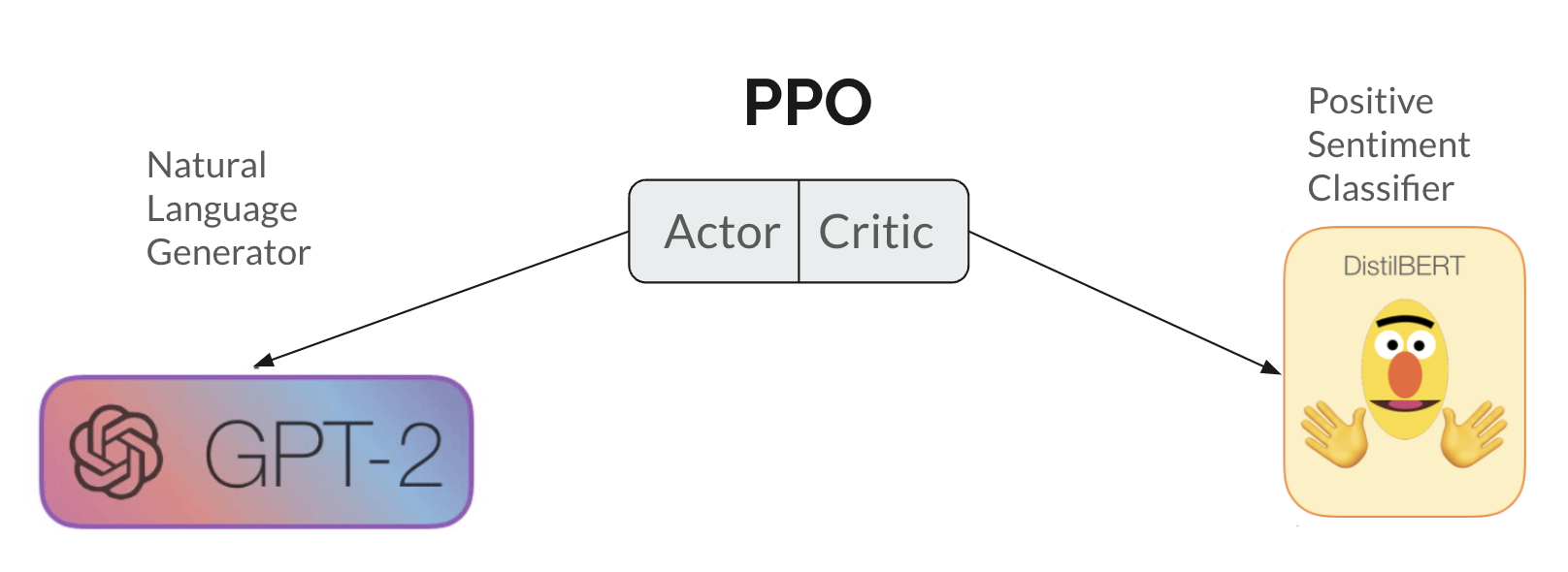
Rather than studying the complex domain of toxicity directly, we designed a controlled experiment focusing on sentiment generation:
- Base Model: GPT-2 fine-tuned on the IMDB movie review dataset
- Alignment Target: Generate positive sentiment responses instead of negative ones
- Reward Model: A DistilBERT classifier trained to detect positive sentiment
- Experimentation: Full access to model weights and activations (white-box analysis)
This setup allowed us to peer inside the model’s “mind” and understand exactly how PPO changes the underlying computations.
Mechanistic Analysis
We used mechanistic interpreptability techniques to conduct our analysis.
Step 1: Identifying “Negative” Weights
Using insights from recent mechanistic interpretability research, we identified which parts of GPT-2 are responsible for generating negative sentiment. Here’s how:
- Trained a sentiment probe on the model’s internal representations
- Found “negative” value vectors using cosine similarity with the probe weights
- Mapped these vectors to vocabulary space to see what concepts they represent
def find_negative_weight_meanings(tokenizer, w_negative, hooked_model, k=5, n_weights=10):
_, scores_gpt2 = get_svd(hooked_model, w_negative, 128)
vectors_of_interest = [
(_score_obj[2], _score_obj[1], _score_obj[0])
for _score_obj in scores_gpt2[:64]
]
topn_negative_value_weights = vectors_of_interest[:n_weights]
for layer, idx, _ in topn_negative_value_weights:
decode_topk(tokenizer, hooked_model, layer, idx, k)
What we found: Specific neurons in layers 6-9 consistently activated for negative concepts like “useless,” “disastrous,” “fail,” and “bad.”
| Layer | Index | Top Negative Tokens |
|---|---|---|
| 7 | 2394 | useless, mediocre, worthless |
| 6 | 2360 | unus, disastrous, deteriorated |
| 9 | 3047 | negligible, diminished, fewer |
| 7 | 2464 | fail, Fail, Wrong |
Step 2: PPO Training Results
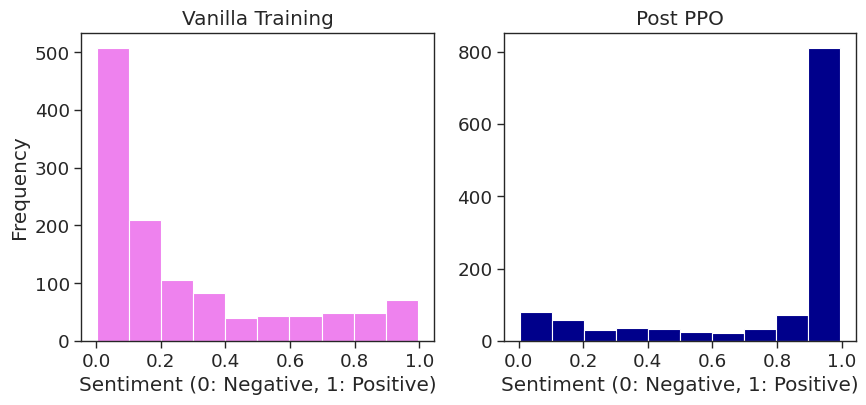
After PPO training, our model successfully learned to generate positive sentiment:
- Original model: Average sentiment score of 0.27
- PPO-trained model: Average sentiment score of 0.80
The alignment worked! But how did it work?
PPO Doesn’t Remove Negative Weights
Here’s where our investigation revealed something surprising about how PPO actually works:
Finding #1: Weights Are Barely Changed
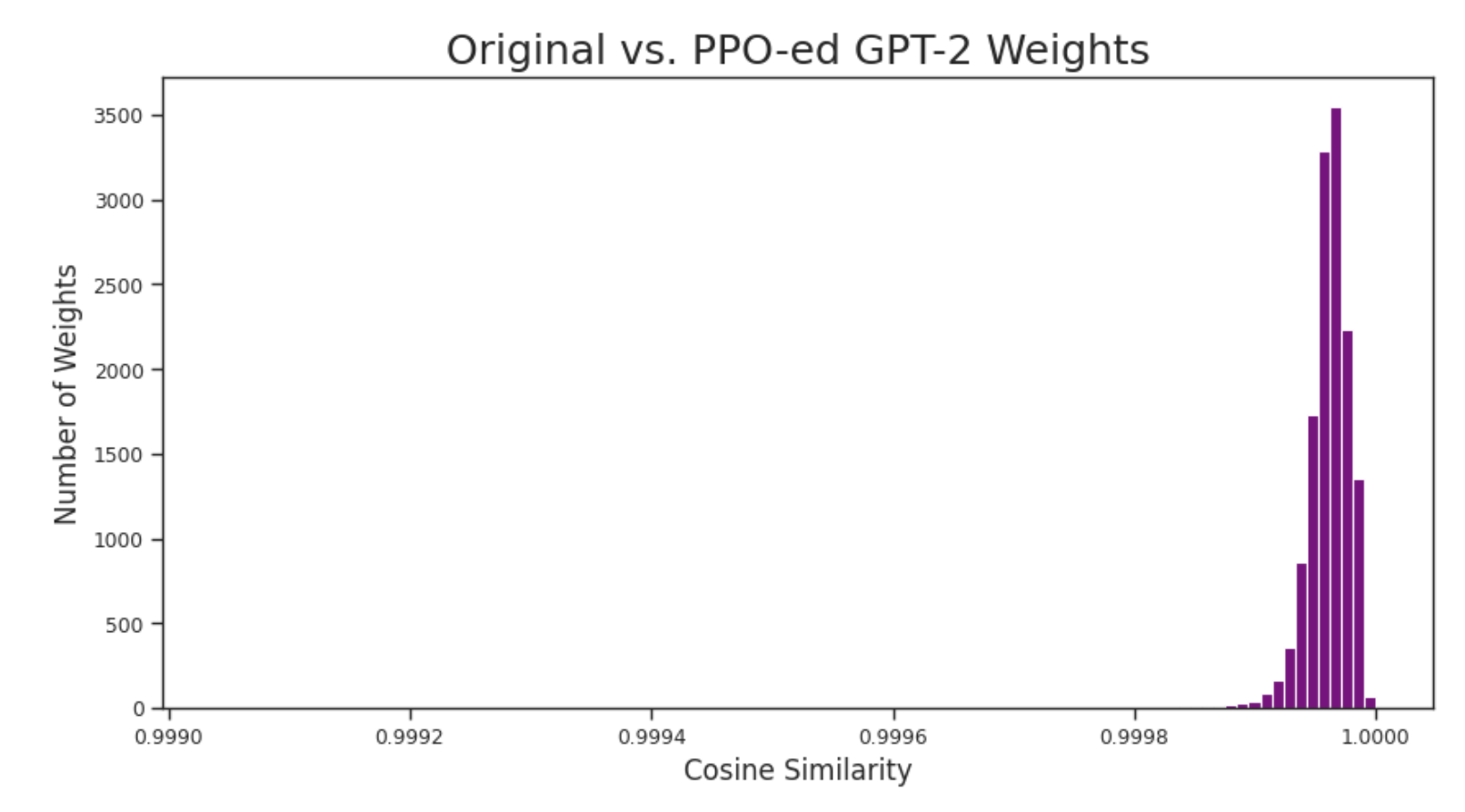
# Calculate cosine similarity between original and PPO weights
sims = []
for name, param in model.state_dict().items():
if 'h.11.' in name or 'h.10.' in name:
param_ppo = trainer.model.state_dict()['base_model.' + name]
curr_sim = F.cosine_similarity(param, param_ppo, dim=0).cpu()
sims.extend(list(curr_sim))
Result: Almost all weights maintained cosine similarity ≥ 0.9998 with their original values!
Finding #2: Negative Weights Remain Intact
The “negative” weights we identified earlier? They were virtually unchanged after PPO training:
| Layer | Index | Original Tokens | PPO-ed Tokens |
|---|---|---|---|
| 7 | 2394 | useless, mediocre, worthless | useless, mediocre, worthless |
| 6 | 2360 | unus, disastrous, deteriorated | unus, disastrous, deteriorated |
| 9 | 3047 | negligible, diminished, fewer | negligible, diminished, fewer |
Implication: PPO didn’t remove the model’s knowledge of negative concepts—it just learned to avoid expressing them.
Finding #3: Activations Change, Not Weights
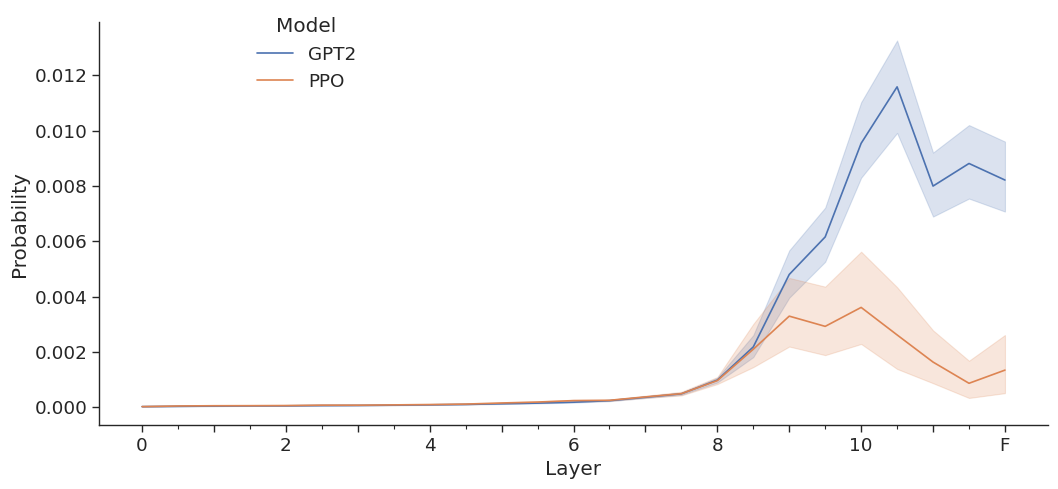
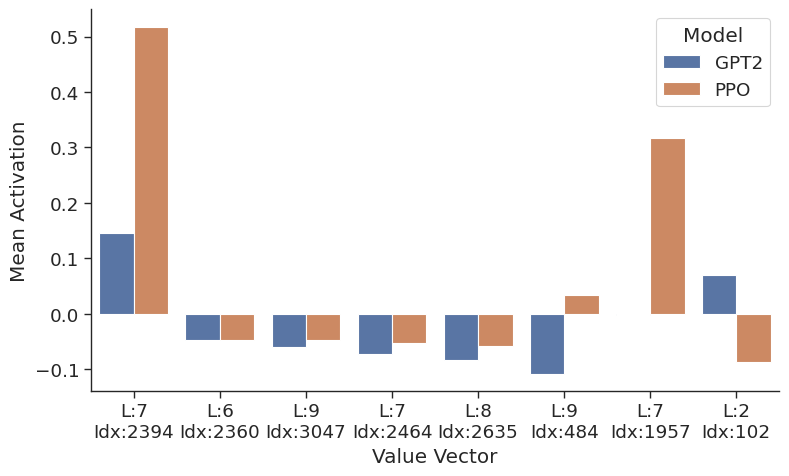
Using the “logit lens” technique, we tracked how concepts flow through the model’s residual stream:
# Track negative concept activations across layers
def logit_lens_analysis(model, negative_vectors, prompts):
activations = {}
for layer in range(model.cfg.n_layers):
# Project intermediate representations to vocabulary space
logits = model.unembed(residual_stream[layer])
activations[layer] = track_negative_concepts(logits, negative_vectors)
return activations
Discovery: Negative concepts were still computed internally but were systematically suppressed in the residual stream as information flowed through the model.
The Hack: Exploiting PPO’s Weakness
Armed with this mechanistic understanding, we designed a “jailbreak” to force the aligned model to generate negative sentiment:
Activation Scaling Attack
def activation_scaling_hack(model, negative_vectors, scale_factor=10):
"""
Scale up activations corresponding to negative value vectors
"""
def hook_fn(module, input, output):
# Identify negative concept activations
for layer, idx in negative_vectors:
if is_negative_activation(output, layer, idx):
# Scale up by factor of 10
output[:, :, idx] *= scale_factor
return output
# Register hooks on MLP layers
for layer in range(6, 10): # Layers containing negative weights
model.blocks[layer].mlp.register_forward_hook(hook_fn)
Result: By scaling the activations of negative value vectors by a factor of 10, we successfully “jailbroke” the aligned model:
- PPO-aligned model: 0.80 average sentiment score
- After activation scaling: 0.43 average sentiment score (back to negative!)
Implications: What This Means for AI Safety
Our findings reveal a fundamental limitation in current alignment approaches:
1. Alignment ≠ Capability Removal
PPO doesn’t actually remove harmful capabilities—it learns a “wrapper” that avoids expressing them. The underlying knowledge remains intact and potentially exploitable.
2. White-Box Vulnerability
If an adversary has access to model weights (increasingly common with open-source models), they can potentially reverse-engineer alignment measures.
3. The Offset Problem
Similar to findings in other research, PPO learns an “offset” that shifts the model’s behavior without fundamentally altering its internal representations.
Attempted Solution: Regularization-Based Mitigation
We experimented with modifying the PPO objective to actively penalize negative weights:
# Modified reward function
r_modified = r_original - λ₁ * r_KL + λ₂ * Σ(||w - w_original||)
# negative weights
Where:
-
r_original: Standard PPO reward (positive sentiment) -
λ₁ * r_KL: KL divergence penalty (standard) -
λ₂ * Σ(||w - w_original||): Penalty for preserving negative weights
Challenge: Finding the right balance proved difficult:
- λ₂ too low: Negative weights remain unchanged
- λ₂ too high: Model loses coherent language generation capabilities
Future Directions: Toward More Robust Alignment
Our research suggests several promising directions:
1. Mechanistic-Informed Alignment
- Use interpretability tools to identify and specifically target harmful representations
- Design training objectives that explicitly modify problematic weights
2. Adversarial Robustness Testing
- Systematically test aligned models against mechanistic attacks
- Develop benchmarks for alignment robustness beyond behavioral evaluation
3. Fundamental Architecture Changes
- Explore architectures that make harmful capabilities truly removable
- Investigate whether different training paradigms avoid the “offset” problem
Conclusion: The Road Ahead
Our study of PPO-aligned GPT-2 reveals that current alignment techniques may be more fragile than they appear. While PPO successfully changes surface behavior, it leaves underlying capabilities largely intact—creating potential vulnerabilities that could be exploited by sophisticated adversaries.
This doesn’t mean current alignment research is worthless, but it does suggest we need:
- More robust evaluation methods that go beyond behavioral testing
- Mechanistic understanding of how alignment techniques actually work
- Adversarial red-teaming to identify potential failure modes
- Fundamental advances in alignment techniques that address root causes
As systems become more powerful, understanding these fundamental limitations becomes increasingly critical. The path to truly safe and aligned AI will require not just better training techniques, but a deeper understanding of how these techniques actually change the models we’re trying to align.
The complete codebase and experimental details are available on GitHub. This work was conducted in collaboaration with David Getzen.
Technical Appendix
Mechanistic Interpretability:
- Logit Lens: Project intermediate representations to vocabulary space
- Value Vector Analysis: Identify which neurons promote specific concepts
- Activation Patching: Modify internal activations to test causal effects
Training Configuration:
PPOConfig(
num_rollouts=128,
chunk_size=128,
ppo_epochs=4,
init_kl_coef=0.001,
cliprange=0.2,
gen_kwargs=dict(max_new_tokens=40, top_k=0, top_p=1.0, do_sample=True)
)
Evaluation Metrics:
- Sentiment classification scores (DistilBERT-IMDB)
- Weight cosine similarity analysis
- Activation magnitude tracking
- Token-level negative concept detection
Reproducibility
All experiments were conducted using the trlx library for RLHF training and transformer_lens for mechanistic interpretability analysis.
References
Please see the preprint for the full references.